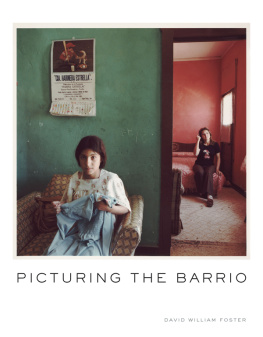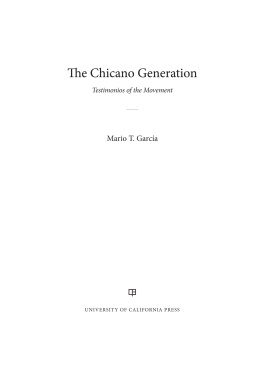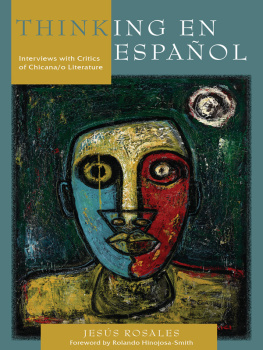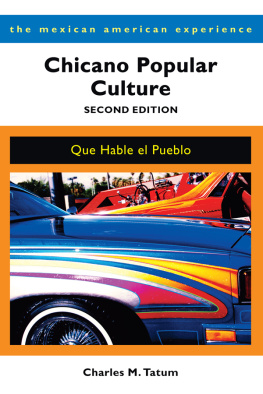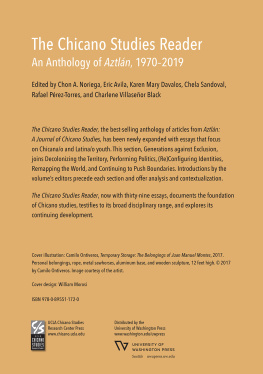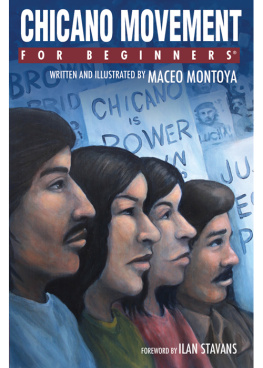FLYING UNDER THE RADAR WITH THE
ROYAL CHICANO AIR FORCE
Mapping a Chicano/a Art History
Ella Maria Diaz

UNIVERSITY OF TEXAS PRESS
AUSTIN
Copyright 2017 by the University of Texas Press
All rights reserved
First edition, 2017
Publication of this book has been aided by a grant from the Wyeth Foundation for American Art Publication Fund of the College Art Association.
Requests for permission to reproduce material from this work should be sent to:
Permissions
University of Texas Press
P.O. Box 7819
Austin, TX 78713-7819
http://utpress.utexas.edu/index.php/rp-form
Library of Congress Cataloging-in-Publication Data
Names: Diaz, Ella Maria, author.
Title: Flying under the radar with the Royal Chicano Air Force : mapping a Chicano/a art history / Ella Maria Diaz.
Description: First edition. | Austin : University of Texas Press, 2017. | Includes bibliographical references and index.
Identifiers: LCCN 2016039539| ISBN 978-1-4773-1203-2 (cloth : alk. paper) | ISBN 978-1-4773-1230-8 (pbk. : alk. paper) | ISBN 978-1-4773-1241-4 (library e-book) | ISBN 978-1-4773-1242-1 (nonlibrary e-book)
Subjects: LCSH: Royal Chicano Air Force. | Mexican American artsCaliforniaHistory. | Mexican American artistsCalifornia. | Social movements in artHistory. | Chicano movementCaliforniaHistory.
Classification: LCC NX512.3.M4 D53 2017 | DDC 704.03/6872073dc23
LC record available at https://lccn.loc.gov/2016039539
doi:10.7560/312032
To students who want to make our world better
CONTENTS
ACKNOWLEDGMENTS
This book has taken a long time to complete, and I have many people to thank. I am grateful to the RCAF members who shared their stories, memories, and art with me for over a decade. Esteban Villa and Juanishi Orosco, my project began with you on December 23, 2000. Irma Lerma Barbosa, thank you for your time, photographs, and records that have enriched the book. I am grateful to Lorraine Garca-Nakata for sharing her photographs and memories with me. Thank you to Juan Carrillo, Stan Padilla, Sam Rios Jr. and Christina Ramrez-Rios, Josephine Talamantez, Clara Favela, Malaquias Montoya and Lezlie Salkowitz-Montoya, Toms Montoya, Nalii Padilla-Delap, Elicia Cervantes-Powell, Terezita Romo, and Rudy Cuellar. To Juan Cervantes, Ricardo Favela, Armando Cid, Sam Quiones, Jos Montoya, Jennie Baca, and all RCAF members who have passed, I write in your memory. I would like to thank the staff at the California Ethnic and Multicultural Archives at UC Santa Barbara, especially Salvador Gerea, Callie Bowdish, and Mari Khasmanyan. I would like to thank Sheila ONeill, Chris Rockwell, and Julie Thomas at the Department of Special Collections and University Archives at CSU Sacramento. My thanks to Leisa D. Meyer, Charles McGovern, Alan Wallach, and Susan V. Webster, who served on my dissertation committee at the College of William and Mary, along with Salvador Gerea. To my colleagues both near and far, including Mary Pat Brady, Margo Crawford, Karen Mary Davalos, Colin Gunckel, Carlos Jackson, Tiffany Ana Lpez, and Eliza Rodriguez y Gibson, I thank you for your support. It has been an honor and my good fortune to work with Ananda Cohen-Aponte at Cornell. I am indebted to professors C. Ondine Chavoya and Rafael Prez-Torres, who reviewed my manuscript early on and helped me conceptualize a stronger book. My sincere gratitude to Kevin Cruz for his hard work and passion for archives and Chicano/a art history. To the English Department and Latino Studies Program at Cornell, thank you for the support and research funds to help me realize my project. I am indebted to the Woodrow Wilson National Fellowship Foundation and the Career Enhancement Fellowship for Junior Faculty. I would like to thank my friends Stephanie Sauer and Janell Lacayo for their encouragement as I descended into rewrites. Last, but not least, my dear parents, David and Cristine Diaz, you have always had my back and have made everything I wanted to pursue possible. Thanks to you, I have finally finished the book.
c/s
PREFACE
A Flight Formation
I first read the phrase In the Royal Chicano Air Force, we fly below the radar in the summer of 2000, when I picked up the local newspaper, the Sacramento Bee, and boarded a plane from Sacramento, California, to Williamsburg, Virginia. Having earned my bachelors degree in American literature, I was moving to the US Southeast to begin my graduate education in the American Studies Program at the College of William and Mary. I planned to study dialect literature and its relationship to African American voices in film.
Preparing for liftoff, I turned to a favorite columnist who commented on various happenings in Sacramento. In an article entitled Murals Pack a Hidden Punch, the columnist praised the restoration of the wall murals lining the K Street tunnel between the Downtown Plaza and Old Sacramento (Graswich 2000). I had never considered the origins of these massive murals, but I learned that Chicano artist Esteban Villa had created one of the murals, and his colleague Juanishi Orosco had created the other one. Villa was mentioned in the column as saying, Pedestrians will be rewarded if they look deep inside the designs for farm laborers and a farm truck. In the Royal Chicano Air Force, we fly below the radar (Graswich 2000). Having passed the murals for years, I wondered about the hidden images. I also wondered who or what was the Royal Chicano Air Force (RCAF).
High above the ground, flying toward someplace else, I recalled the moment in Jos David Saldvars (1997) Border Matters when he reflects on his education in South Texas. While very much the center of Saldvars universe, his hometown was also a place where history began and ended with the master periodizing narratives of the Alamo. Saldvar writes, I learned all the hard facts about regional hegemony and global colonialisms cultures, for culture, my teachers believed, always lived somewhere elsenever in our own backyard (160). In my case, or rather, on my plane, I realized I too believed American culture lived somewhere else. Much like Saldvar, who left South Texas to study American literature at Yale in 1973, I headed to Virginia in 2000 to learn about American culture because I thought I knew hardly anything about America (Saldvar 1997, 159). Flying away from the center of my universe, reading an intriguing blurb about hometown murals, I entered a state of Nepantla in the Anzaldan sense.
Nepantla is a Nahuatl word for a space between two bodies of water, the space between two worlds (Anzalda 1999, 237). My lack of Chicano/a consciousness in 2000 mirrors its absence from the historical consciousness of the United States to date.
INTRODUCTION
Mapping the Chicano/a Art History of the Royal Chicano Air Force
The Royal Chicano Air Force (RCAF) Chicano/a art collective produced major works of art, poetry, prose, music, and performance in the United States during the second half of the twentieth century and the first decades of the twenty-first. Merging the hegemonic signs, symbols, and texts of two nations with particular but often fragmented knowledge of their indigenous ancestries, members of the RCAF were among a generation of Chicano/a artists in the 1960s and 1970s who revolutionized traditional genres of art through fusions of content and form in ways that continue to influence artistic practices in the twenty-first century. Encompassing artists, students, military veterans, community and labor activists, professors, poets, and musicians (and many members who identified with more than one of these terms), the RCAF redefined the meaning of artistic production and artwork to account for their expansive repertoire, which was inseparable from the community-based orientation of the group. The RCAF emerged in Sacramento, California, in 1969 and became established between 1970 and 1972.designed flyers, but they also planned and staged neo-indigenous ceremonies and directed and implemented the collectives political and community infrastructure.
Next page

